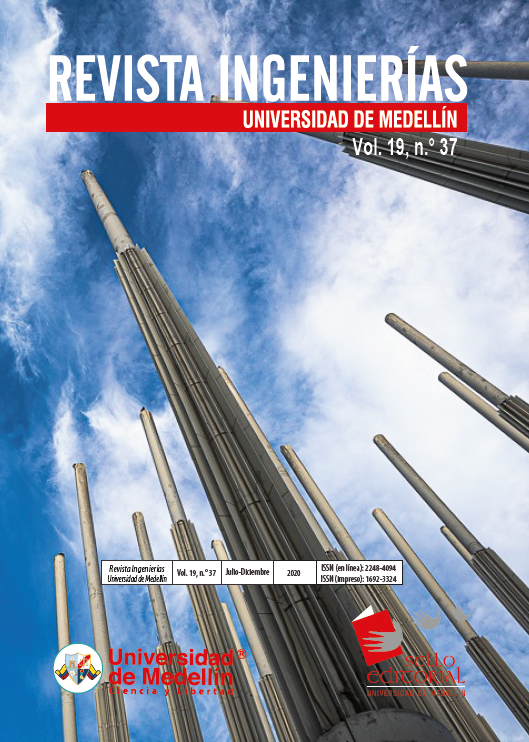Derechos de autor 2023 Revista Ingenierías Universidad de Medellín

Esta obra está bajo licencia internacional Creative Commons Reconocimiento-NoComercial-SinObrasDerivadas 4.0.
- Articles
- Enviado: diciembre 1, 2019
-
Publicado: marzo 18, 2020
Resumen
Este artículo muestra un trabajo en el que se investigan numéricamente las propiedades de transporte de los patrones de una red cuadrada bidimensional construida a partir de una secuencia de ADN telomérico, a través de un modelo tight-binding efectivo para la estructura electrónica, mientras que la corriente se obtiene dentro del marco de funciones de Green. Se muestra que las estructuras de ADN autoensambladas basadas en cadenas de ADN teloméricas tienen características de voltaje de corriente con una robusta secuencia de escalones que favorecen el control del ADN con los contactos, así como los efectos de interferencia. Se observan variaciones interesantes del mecanismo de percolación, que dependen de la competencia entre la longitud de localización y la distancia entre los cruces en las estructuras de red cuadrada bidimensional autoensambladas, las cuales hacen que el sistema sea elegible para aplicaciones nanoelectrónicas.
Referencias
- [1] N. C. Seeman, and H. F. Sleiman, “DNA nanotechnology,” Nature Reviews Materials, vol. 3, p. 17068, 11 2018. DOI: 10.1038/natrevmats.2017.68.
- [2] N. C. Seeman, “DNA in a material world,” Nature, vol. 421, no. 6921, p. 427, 2003. DOI: 10.1038/nature01406.
- [3] G. M. Whitesides, and B. Grzybowski, “Self-assembly at all scales,” Science, vol. 295, no. 5564, pp. 2418–2421, 2002. DOI: 10.1126/science.1070821.
- [4] J. R McMillan et al., “Protein Materials Engineering with DNA” Acc. Chem. Res vol. 52, no. 7, p. 1939, 2019. DOI: 10.1021/acs.accounts.9b00165.
- [5] J. Nangreave, D. Han, Y. Liu, and H. Yan, “DNA origami: a history and current perspective,”Current Opinion in Chemical Biology, vol. 14, no. 5, p. 608, 2010. DOI: 10.1016/j.cbpa.2010.06.182.
- [6] A. Mangalum, M. Rahman, and M. L. Norton, “From DNA Nanotechnology to Material Systems Engineering” advanced materials, vol. 31, p. 1806294, 2019. DOI: 10.1002/adma.201806294.
- [7] J. Y. Kishi, T. E. Schaus, N. Gopalkrishnan, F. Xuan, and P. Yin, “Programmable autonomous synthesis of single-stranded DNA,” Nature Chemistry, vol. 10, p. 155, 2017. DOI: https://doi.org/10.1038/nchem.2872
- [8] X. Liu, F. Zhang, X. Jing, M. Pan, P. Liu, W. Li, B. Zhu, J. Li, H. Chen, L. Wang, J. Lin, Y. Liu, D. Zhao, H. Yan, and C. Fan, “Complex silica composite nanomaterials templated with DNA origami,” Nature, vol. 559, no. 7715, p. 593, 2018. DOI: https://doi.org/10.1038/s41586-018-0332-7
- [9] T. Lin, J. Yan, L. L. Ong, J. Robaszewski, H. D. Lu, Y. Mi, P. Yin, and B. Wei, “Hierarchical assembly of DNA nanostructures based on four-way toehold-mediated strand displacement,” Nano Letters, vol. 18, no. 8, p. 4791, 2018. DOI: https://doi.org/10.1021/acs.nanolett.8b01355
- [10] D. Y. Tam, X. Zhuang, S. W. Wong, and P. K. Lo, “Photoresponsive self-assembled DNA nanomaterials: Design, working principles, and applications,” Small, vol. 15, no. 26, p. 1805481, 2019. DOI: 10.1002/smll.201805481.
- [11] Y. Li, and R. Schulman, “DNA nanostructures that self-heal in serum,” Nano Letters, vol. 19, no. 6, p. 3751, 2019. DOI: 10.1021/acs.nanolett.9b00888.
- [12] C. Páez, and P. Schulz, “Electronic localization at mesoscopic length scales: different definitions of localization and contact effects in a heuristic DNA model,” Eur. Phys. J. B, vol. 86, p. 104, 2013. DOI: 10.1140/epjb/e2013-30728-9.
- [13] R. Gutiérrez, S. Mandal, and G. Cuniberti, “Quantum transport through a DNA wire in a dissipative environment,” Nano Letters, vol. 5, no. 6, p. 1093, 2005. DOI: 10.1021/nl050623g.
- [14] C. J. Páez, and P. A. Schulz, “Delocalization of vibrational normal modes in double chains: Application to DNA systems,” Microelectronics Journal, vol. 39, no. 11, p. 1222, 2008. DOI: 10.1016/j.mejo.2008.01.007.
- [15] C. J. Páez, P. A. Schulz, N. R. Wilson, and R. A. Roemer, “Robust signatures in the current–voltage characteristics of DNA molecules oriented between two graphene nanoribbon electrodes,” New Journal of Physics, vol. 14, no. 9, p. 093049, 2012. DOI: 10.1088%2F1367-2630%2F14%2F9%2F093049.
- [16] C.-T. Shih, S. Roche, and R. Roemer, “Point-mutation effects on charge-transport properties f the tumor-suppressor gene p 53,” Physical review letters, vol. 100, p. 018105, 02 2008.
- DOI: 10.1103/PhysRevLett.100.018105.
- [17] C. J. P´aez, R. Rey-Gonz´alez, and P. A. Schulz, “Macroscopic localization lengths of vibrational normal modes in a heuristic DNA model,” Phys. Rev. B, vol. 81, p. 024203, Jan 2010. DOI: 10.1103/PhysRevB.81.024203.
- [18] S. A. Wells, C.-T. Shih, and R. A. Römer, “Modelling charge transport in DNA using transfer matrices with diagonal terms,” vol. 23, p. 4138, 2009. DOI: 10.1142/S0217979209063328.
- [19] J. Rak, A. Voityuk, A. Márquez, and N. Rösch, “The effect of pyrimidine bases on the hole-transfer coupling in DNA,” vol. 106, no. 32, p. 7919, 2002. DOI: 10.1021/jp014261m.
- [20] M. P. L. Sancho, J. M. L. Sancho, J. M. L. Sancho, and J. Rubio, “Highly convergent schemes for the calculation of bulk and surface green functions,” Journal of Physics F: Metal Physics, vol. 15, no. 4, p. 851, 1985. DOI: 10.1088%2F0305-4608%2F15%2F4%2F009.
- [21] N. B. Larsen, H. Biebuyck, E. Delamarche, and B. Michel, “Order in microcontact printed self-assembled monolayers,” Journal of the American Chemical Society, vol. 119, no. 13, p. 3017, 1997. DOI: 10.1021/ja964090c.
- [22] D. Porath, A. Bezryadin, S. De Vries, and C. Dekker, “Direct measurement of electrical transport through DNA molecules,” vol. 403, p. 635, 2000. DOI: 10.1038/35001029.
- [23] H. Cohen, C. Nogues, R. Naaman, and D. Porath, “Direct measurement of electrical transport through single DNA molecules of complex sequence,” vol. 102, p. 11589, 2005. DOI: 10.1073/pnas.0505272102.
- [24] C. Lewenkopf, and E. Mucciolo, “The recursive green’s function method for graphene,” Journal of Computational Electronics, vol. 12, no. 203, p. 203, 2013. DOI: 10.1007/s10825-013-0458-7.


















